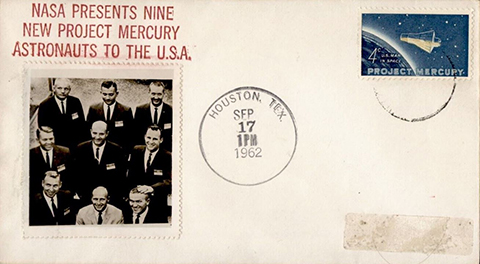Space Cover 679: Group 2 NASA Astronaut SelectionOn April 18, 1962, NASA launched a campaign for its "Flight Crew Training Program" to select five to 10 new astronauts. At the time NASA only had the seven astronauts selected in April 1959 for the Mercury program to fill out crews to test and operate the new two-seat Gemini spacecraft so new astronauts needed to be selected and trained.
From the 253 applications received by the June 1 deadline (including one that had arrived a week late but was still accepted), NASA narrowed the field down to 32 finalists who underwent intensive medical examinations at Brooks Air Force Base in San Antonio. During this phase, physicians disqualified one candidate for exceeding the height requirement.
In July and August, the 31 finalists appeared before the selection board for further tests and interviews by Coordinator of Astronaut Activities Donald "Deke" Slayton and the other members of the board.
On September 14, Slayton telephoned the nine newly-selected astronauts with the good news.
Robert Gilruth, director of the Manned Spacecraft Center in Houston introduced the nine new astronauts during a press conference held at the University of Houston's Cullen Auditorium on September 17.
The "Next Nine" as the group called themselves, consisted of four Air Force, three Navy, and for the first time two civilian pilots. This second group of NASA astronauts included Neil Armstrong (civilian), Frank Borman (U.S. Air Force), Charles "Pete" Conrad (U.S. Navy), James Lovell (U.S. Navy), James McDivitt (U.S. Air Force), Elliot See (civilian), Thomas Stafford (U.S. Air Force), Edward White (U.S. Air Force), and John Young (U.S. Navy).
Tragically, Elliot See died in a plane crash while training for his first mission, and Ed White, who flew on Gemini 4, died in the Apollo 1 fire. The seven remaining members of the group flew missions in the Gemini and Apollo programs, with six traveling to the Moon and three walking on its surface. In addition, Pete Conrad later flew a long-duration mission aboard Skylab, and Tom Stafford later flew on the first joint flight with the Soviet Union, and John Young later flew twice on the space shuttle, including its inaugural voyage STS-1.
The cover shown has a "Harry Gordon like" paste on black-and-white photo cachet of the group 2 astronauts. It is postmarked in Houston with a general-purpose hand cancel.















